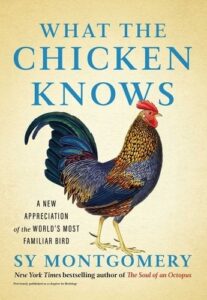 Welcome to the latest installment of “Five words from …” our series which highlights interesting words from interesting books! In this installment, Sy Montgomery recounts her poultry husbandry journey, showing us that the “chickenverse” is a deeper and more interesting place than we imagined.
Welcome to the latest installment of “Five words from …” our series which highlights interesting words from interesting books! In this installment, Sy Montgomery recounts her poultry husbandry journey, showing us that the “chickenverse” is a deeper and more interesting place than we imagined.
“The word ‘augury’ comes from the Greek word meaning ‘bird talk’, for to understand the language of birds was to understand the gods.”
Montgomery’s chickens communicated with her and each other through elaborate noises that conveyed specific meanings. For more on how birds communicate, check out Barbara Ballentine and Jeremy Hyman’s Bird Talk: An Exploration of Avian Communication.
“When Peanut was a year and a half old she developed a blockage in her crop–the muscular compartment where birds store and soften their food.”
The average chicken’s crop can hold about an ounce and a half of food.
“There was the skunk, and another time a mink, another time a neighbor’s dog and once an ermine. The tiny ferocious weasel in its snowy winter coat had slipped through our barn’s foundation and decapitated one of our hens.”
Keeping live chickens is an invitation to meet the local predators and Montgomery encountered plenty of wild animals eager for chicken dinners. The ermine (also called a stoat) is a common visitor to chicken coops across Europe and North America.
“Then it starts all over again, until the hen has had enough and has reached what we call “overpet.” She fluffs her feathers, shakes, and, fortified by affection, strolls off to continue her chicken day.”
Many animals have less-patient responses than chickens to overstimulation (sometimes called sensory overload).
“And just as the hens always do with me, she assumed her distinctive squatting posture. This is a well-known chicken behavior usually directed at a member of her own species. It is actually known as a “sex crouch.” It’s a position that a chicken normally uses to make it easy for a rooster to mount her.”
Hens will begin showing this behavior (called lordosis in mammals) when they are mature enough to start laying. When chickens see a human they know, they might squat in this position, hoping to be picked up or petted.